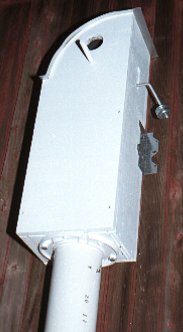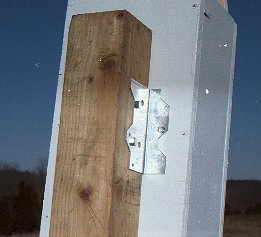
Automatic Repeating Nest Box Trap
For Starlings and House Sparrows

Automatic Repeating Nest Box Trap
For Starlings and House Sparrows
 This new automatic repeating starling trap has performed well in the 2004-6 seasons. It is somewhat lighter and has a simpler mechanism than the tipping can traps. Video monitoring has demonstrated a 100 percent capture rate with starlings, Recent trap data suggests it is quite effective with house sparrows, but none were present during the earlier video monitoring, so catch rates couldn't be determined. In aviary testing with captive house sparrows in March, 2005, a male learned to temporarily avoid tripping the trap after being caught 17 times. The previous record, prior to several minor modifications, was 5 times. No sparrow has been observed to escape on its first visit. The automatic trap never needs to be reset and will deliver any number of starlings or sparrows to the holding cage below. Frequent monitoring of the trap is necessary, in order to promptly remove starlings and house sparrows or to release any native bird that might enter. Mounting the trap under the eaves of a building greatly lessens the chance that a native bird will enter while increasing the number of starlings caught. When the trap can't be monitored, simply removing the holding cage will allow birds to pass down the tube unscathed.
This new automatic repeating starling trap has performed well in the 2004-6 seasons. It is somewhat lighter and has a simpler mechanism than the tipping can traps. Video monitoring has demonstrated a 100 percent capture rate with starlings, Recent trap data suggests it is quite effective with house sparrows, but none were present during the earlier video monitoring, so catch rates couldn't be determined. In aviary testing with captive house sparrows in March, 2005, a male learned to temporarily avoid tripping the trap after being caught 17 times. The previous record, prior to several minor modifications, was 5 times. No sparrow has been observed to escape on its first visit. The automatic trap never needs to be reset and will deliver any number of starlings or sparrows to the holding cage below. Frequent monitoring of the trap is necessary, in order to promptly remove starlings and house sparrows or to release any native bird that might enter. Mounting the trap under the eaves of a building greatly lessens the chance that a native bird will enter while increasing the number of starlings caught. When the trap can't be monitored, simply removing the holding cage will allow birds to pass down the tube unscathed.
 The trap is constructed from 3/4" exterior plywood, fastened with galvanized screws and painted white. All sides and edges of the plywood parts are painted before assembly, thus protecting even the concealed edges of the plywood from moisture. The curved aluminum roof conforms to the radius of the tipping wall and prevents the starling from escaping over the wall as it moves downward. The tipping floor and wall is shaped from 28 gauge galvanized steel. A metal hole cover extends from the tipping wall to the edge of the entrance hole and immediately covers the entrance as the floor begins to drop under the bird's weight. The counterweight is fully adjustable. A pvc flange is mounted on the bottom to accept light weight 4" pvc drain pipe.
The trap is constructed from 3/4" exterior plywood, fastened with galvanized screws and painted white. All sides and edges of the plywood parts are painted before assembly, thus protecting even the concealed edges of the plywood from moisture. The curved aluminum roof conforms to the radius of the tipping wall and prevents the starling from escaping over the wall as it moves downward. The tipping floor and wall is shaped from 28 gauge galvanized steel. A metal hole cover extends from the tipping wall to the edge of the entrance hole and immediately covers the entrance as the floor begins to drop under the bird's weight. The counterweight is fully adjustable. A pvc flange is mounted on the bottom to accept light weight 4" pvc drain pipe.
July, 2010 Update - It has become apparent in the past two years that removing large numbers of starlings in my repeating traps still doesn't ensure a successful flicker nesting in our yard. Video monitoring flicker boxes and removing starlings as they usurp these boxes does work. Monitoring the flicker boxes, even off season, provided a number of surprises, which I will write up as time and weather allows (the laptop doesn't like this hot weather and we have an ac free property). In the meantime, I'm not inclined to make more repeating traps, since they aren't the panacea I had thought. A simple pivoting hole cover on each flicker box, released by a solenoid or pull string and a camera with capture box and motion detection to monitor what is inside the box allowed me to record all nest box visits. When a new pair of starlings began entering the box, I would then watch live video and pull the string or push the button when they entered. One surprise in monitoring the boxes was that starlings were repeatedly driving off a flicker during autumn and winter, well before their nesting season. Unlike the male flicker, they never used the box for a night roost in winter, but seemed to be reserving it for spring.
Using starling nest box traps
2004 nest box trap research - trap modifications and locations
Starling and flicker competition
remote solenoid nest box traps
artificial nest black hole traps
The European starling in America
the pellet gun - a valuable tool in house sparrow and starling control
| barn owl | American kestrel | purple martin | barn swallow | Eastern bluebird |
| tufted titmouse | Eastern phoebe | yellow shafted flicker | tree swallow | chimney swift |
| house wren | big brown bat | Carolina wren | brown thrasher | catbird |
| Eastern wood-pewee | cedar waxwing | Northern mockingbird | Turkey vulture | |